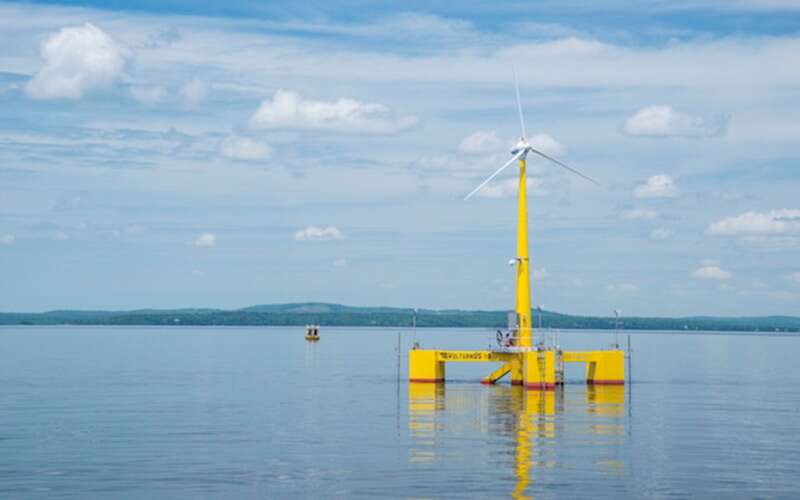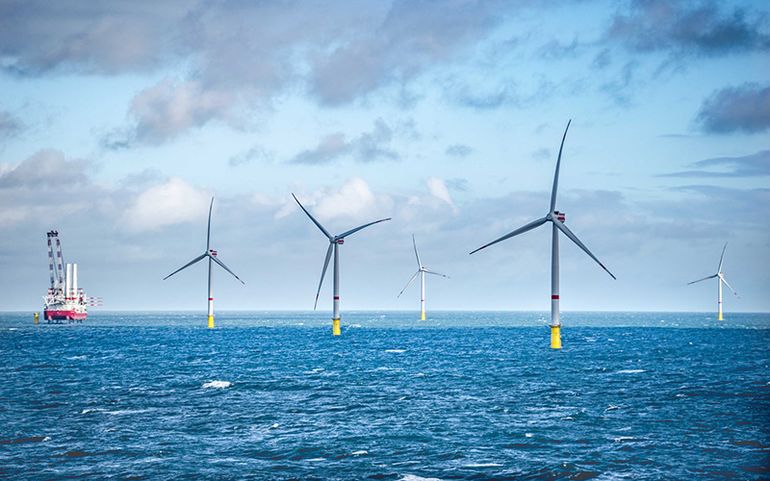
Maine Aqua Ventus awaits PUC decision as offshore wind takes off elsewhere
 Courtesy / Vineyard Partners
Vineyard Wind, which is backed by Avangrid Renewables and its partner Copenhagen Infrastructure Partners, was selected two weeks ago by Massachusetts to develop an 800-megawatt wind farm 15 miles off the coast of Martha's Vineyard. The project, which is subject to successful negotiations over a power-purchase agreement and state and federal permits. would become the first industrial-scale offshore wind project in the United States.
Courtesy / Vineyard Partners
Vineyard Wind, which is backed by Avangrid Renewables and its partner Copenhagen Infrastructure Partners, was selected two weeks ago by Massachusetts to develop an 800-megawatt wind farm 15 miles off the coast of Martha's Vineyard. The project, which is subject to successful negotiations over a power-purchase agreement and state and federal permits. would become the first industrial-scale offshore wind project in the United States.
The emerging offshore wind industry along the East Coast is picking up momentum, with Massachusetts regulators two weeks ago selecting Vineyard Wind, which is backed by Avangrid Renewables and its partner Copenhagen Infrastructure Partners to develop an 800-megawatt wind farm 15 miles off the coast of Martha’s Vineyard.
That project — which is subject to successful negotiations over a power-purchase agreement and state and federal permits — would become the first industrial-scale offshore wind project in the United States.
Current plans call for construction of Vineyard Wind's project to begin in 2019 and for its roughly 100 turbines to become operational by 2021. The project is expected to create renewable energy for up to 400,000 Massachusetts homes and businesses, create 3,600 jobs and foster the development of the offshore wind supply chain, businesses, and infrastructure in Massachusetts.
And just last week, Rhode Island selected Deepwater Wind, a 400-megawatt offshore wind project that will invest $250 million and use a local workforce of more than 800 to build a offshore wind farm that will produce electricity for up to 200,000 households in the state, the Providence Journal reported.
Meanwhile, the University of Maine-led Maine Aqua Ventus project to install two 6-megawatt offshore wind turbines two-and-a-half miles offshore Monhegan Island remains stalled as the Maine Public Utilities Commission considers reopening the power rate terms it had approved in 2014.
“This is our last chance in Maine to do something that will really transform the state’s economy,” says Habib Dagher, executive director of the University of Maine's Advanced Structures and Composites Center and Aqua Ventus project leader.
Dagher said the Monhegan pilot project is intended to prove the effectiveness, at full scale, of the floating platform technology successfully tested in the 1:8 scale VolturnUS turbine installed in 2014 off Castine, which was the first grid-connected floating offshore wind turbine in the U.S. The significance, he says, is that the offshore wind industry in the U.S. is poised for rapid acceleration and the next-generation projects, both on the East Coast and in Europe, are going to be in waters too deep for anchored platforms.
“We’re talking with European countries,” Dagher told Mainebiz in a conference phone call. “They are all waiting for the PUC to make the decision that will allow us to build a full-scale floating platform and demonstrate its value in the Monhegan pilot project.”
PUC weighs reopening 2014 term sheet

The three-member Maine Public Utilities Commission, all appointed by Gov. Paul R. LePage, in January voted unanimously to seek public comments on whether it should reconsider its February 2014 approval of the power-rate terms between the Maine Aqua Ventus pilot project and Central Maine Power Co.
The commission’s seven-page order caught the University of Maine-led Aqua Ventus team by surprise. They had just completed negotiating the terms of a 20-year power contract with CMP and were expecting to receive PUC’s approval, enabling them to check that off as another milestone the Aqua Ventus project needed to complete in order to secure $37 million in federal funding from the U.S. Department of Energy.
Now, with a new round of public comments to review that were filed by the Feb. 14 deadline, the PUC has not yet made its decision whether it will reopen the terms of the power contract approved in a 2-1 vote four years ago.
Preti Flaherty lawyer Tony Buxton, who is working with UMaine’s lawyer Jeff Thaler on the PUC’s potential reopening of the term sheet, says if that comes to pass it would put Aqua Ventus at great risk of losing the $37 million in federal funding promised by the DOE.
“We thought we were ready to move on to the next stages of this process,” Buxton told Mainebiz in a conference call interview in late April.
'Blindsided'?
Thaler, who was part of that conference call, said he and others on the UMaine team felt blindsided when they showed up at the PUC in early January with a negotiated contract with CMP in hand and the expectation that it would be approved by the three-member commission.
For Thaler, the PUC’s surprise announcement that it would seek public comment on possibly reopening the term sheet was the equivalent of a 180-degree turn from a multi-year deliberative process that culminated with the PUC’s 2-1 approval in 2014 of a 20-year power purchase agreement that would have Aqua Ventus’ two 6MW turbines sell up to 43,000 megawatt hours per year of electricity to the grid at a price of 23 cents per kilowatt hour.
“Everyone signed off on that agreement,” Thaler said of the negotiated contract with CMP that included prior review by PUC staffers. “We showed up at the Jan. 9 meeting under the impression that it was simply procedural.”
PUC's stated reasons
The obvious question: Why is PUC considering reopening the Maine Aqua Ventus power contract now, just when its terms had been agreed-upon by the UMaine-led consortium and CMP?
The PUC’s seven-page order issued on Jan. 24 lists eight reasons. Among them:
- Lower energy prices: Since the 2009 passage of the Ocean Energy Act and its 2014 approval of the Maine Aqua Ventus term sheet, the PUC says “there have been significant changes in domestic and international energy markets.”
- Technology advances: With newer turbines coming online being much larger than the 6MW turbines that would be installed at the pilot project’s test site off Monhegan Island, the PUC asks “whether the technological features of the pilot project are likely to provide the same benefit as originally proposed, given the technological advancements in the offshore wind industry in recent years.
- Renewable energy goals: Since Maine’s current renewable energy resources (chiefly hydro, biomass and wind) exceed the state’s renewable goals, the PUC asks if “changed circumstances” relating to renewable energy in Maine warrant reconsideration of the term sheet.
- Are there tangible economic benefits to Maine manufacturers?: With other states moving rapidly to develop their own offshore wind programs, the PUC asks how realistic are the term sheet’s assumptions about Maine benefiting economically from offshore wind or tidal energy.
- Changes in the project’s ownership structure, the location of the project’s connection to the mainland power grid and the local benefits package to Monhegan that have occurred since 2014. For example, one of Maine Aqua Ventus’ original partners, Emera Inc., has pulled out but has been replaced by a French energy company Naval Energies.
- Connection to the mainland, originally stated as Bristol, remains unresolved, with several sites still being considered.
- Local benefits to Monhegan now are in the form of a lump sum payment, instead of the previous plan to install an underwater transmission cable from the two 6MW turbines to the island that would have provided cheaper electricity than the island's current power source.
Thaler says many of the stated reasons for reopening the terms ignore previously agreed upon principles — most notably, the objections about the above-market cost of the power that CMP will purchase from the pilot project.
“Any demonstration project would have above-market cost,” Thaler said. “That’s been known for years. We put in the price that was as low as we could put it. The commission approved a term sheet that explicitly stated what that price would be. We relied on that term sheet, the U.S. Department of Energy has relied on that term sheet, we spent months negotiating with the PUC to arrive at a power purchase agreement that was eventually presented to CMP.”
Reaction to PUC's decision
Two significant supporters of reopening the term sheet are Steven G. McGrath, director of the Governor’s Energy Office, and James C. LaBrecque, technical adviser on energy for Gov. Paul R. LePage.
In a Feb. 21 letter to the PUC, McGrath wrote: “The Governor objects to the rates as proposed in the term sheet, because they are significantly above the market and will be borne by CMP’s ratepayers. Further, the length of the contract to prove the technology is considerably long for a demonstration project.”
LaBrecque, in his Feb. 21 letter to PUC, wrote (with several words highlighted by him): “On one hand, you have the full boat of CMP ratepayers who will be compelled to finance millions for the Maine Aqua Ventus project, as well as many other Mainers who will face additional occupational hardships (fishing, tourism, etc.) if this project moves forward. On the other hand, you have a few parties who will receive handsome, risk-free financial benefits. These few, sophisticated, well-finance participants are positioned to potentially ‘game the system’ for millions of dollars, while ordinary ratepayers are unaware that such a proceeding even exists. Hardly a fair contest!”
Among those urging PUC not to reopen the 2014 power contract terms is Peter G. Vigue, chairman of The Cianbro Cos., a key business partner in the Aqua Ventus consortium, who wrote in a Feb. 16 letter: “The members of Maine Aqua Ventus and many businesses, public agencies, institutions and many others have relied upon the term sheet in order to rationalize the investment of millions of dollars in advancement of the Maine Aqua Ventus project over these many years.”
Reopening the term sheet and possibly rescinding its terms, he stated, “sends the wrong message to those considering investment in Maine and Maine Aqua Ventus.”
Vigue concluded that Maine Aqua Ventus “is a prototype demonstration project that has the capability to springboard Maine to the forefront of offshore wind development, with critical support from the commission.”
An international perspective

Laurent Schneider-Maunory, chief executive president of Naval Energies, a French company that is now part of the Maine Aqua Ventus consortium, put the Aqua Ventus project in a broader context than simply two 6MW turbines installed off Monhegan Island.
In his Feb. 20 letter to PUC he wrote: “We believe the market opportunity for floating wind turbines is tremendous, three times greater than fixed offshore wind turbines. The Maine Aqua Ventus pilot project is an important milestone in the development of the technology. It will demonstrate the integration of world-leading, innovative hull and mooring technologies designed by the University of Maine and Naval Energies with the proven performance of a GE 6 MW turbine. Success will unlock opportunities for floating wind projects along the eastern seaboard of North America.”
Naval Energies, a global company operating in four continents, has been part of the Aqua Ventus project since January 2015. Its subsidiary, OpenHydro, is developing tidal energy technology in the Bay of Fund with its partner Emera, investing since 2015 $33 million in 125 Nova Scotian companies.
“When market demand warrants it, a local facility to manufacture components for floating wind projects along the Eastern seaboard of North America will be necessary,” Schneider-Maunory wrote. “Should the pilot project continue and be successful, Maine is well placed to host Naval Energies’ manufacturing facility. Maine would export industrial goods to renewable energy projects up and down the eastern seaboard of North America.”
He concluded: “We bring to the project a strong capability in design and construction for marine applications and deployment of assets in complex marine environments. We may choose to prioritize an investment in Maine over other jurisdictions because of the world-leading team at the University of Maine and the support of the state of Maine, as described in the term sheet, approved by order on Dec. 4, 2013.”
What comes next?
In response to emailed questions posed by Mainebiz, Harry Lanphear, administrative director for the PUC, wrote: “From a procedural standpoint, there is no formal or specific deadline for the Commission to make a decision on this matter. We are thoroughly evaluating all the comments we have received in this case. Upon completion of our evaluation the Commission will make a decision. Please note that as this is an active case in front of the Commission, the commissioners cannot comment. The Commission would be happy to discuss procedural aspects of the case if that is helpful.”
Thaler said there are three paths the PUC might take:
- Decide not to reopen the term sheet and move to deliberations on the draft power purchase agreement. From Maine Aqua Ventus’ perspective, he said, that would be the right step to take.
- Decide to reopen and reconsider the term sheet, which would involve directing PUC staff to renegotiate new terms on specific issues.
- Decide the Aqua Ventus project is no longer feasible and reject the term sheet entirely.
“I’m hopeful,” Thaler said. “We explain in great detail why they should not reopen the term sheet. If they pay attention to what we’ve provided, they should do the right thing.”
Buxton said it would be “a huge surprise” if the PUC killed the term sheet entirely. “But we have to be wary of being nibbled to death in small bites,” he added.
Buxton said the Aqua Ventus consortium’s view is that if the PUC reverses itself on the 2014 term sheet, it would be the equivalent of breaking a contract. It also would send a message to investors and businesses, both inside and outside of Maine, that the PUC can’t be trusted to stand by its decisions.
“It’s a story that would run all over the country,” he said, adding his opinion that it would not put Maine in a very favorable light.
“It really depends on what the commission does at this point,” Thaler said. “If they vote to reopen and reconsider the term sheet and substantially change the term sheet, I will recommend to the client that we appeal. It will go the Maine Supreme Judicial Court.”
THURSDAY: “Can offshore wind ignite Maine’s sluggish manufacturing economy?”
Read more
American Jobs Project: Offshore wind could support 2,100 Maine jobs annually
American Jobs Project: Offshore wind could support 2,100 Maine jobs annually













Comments